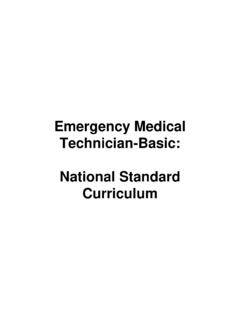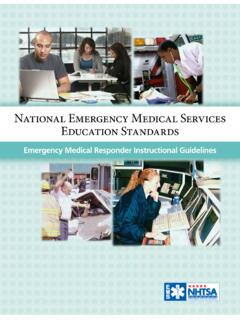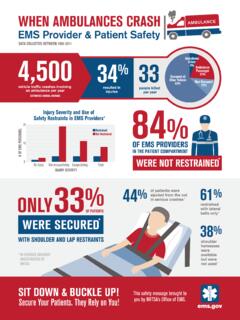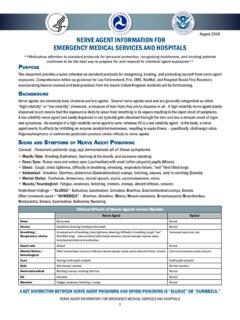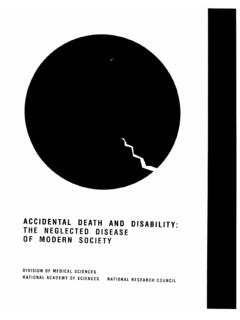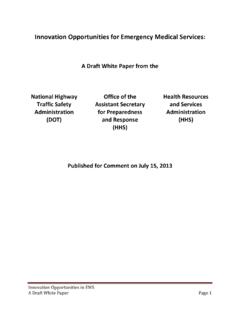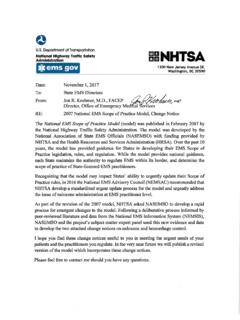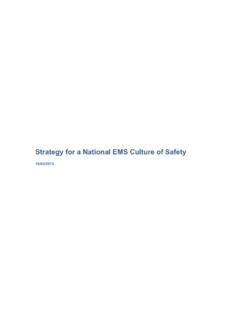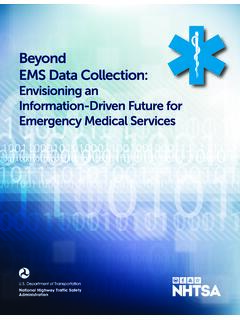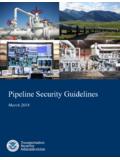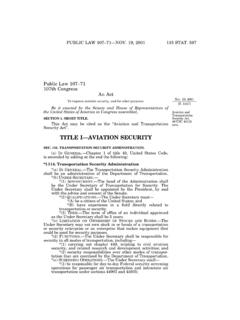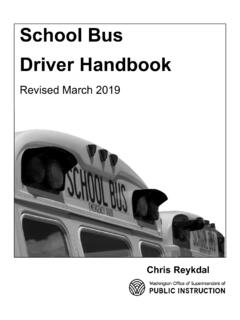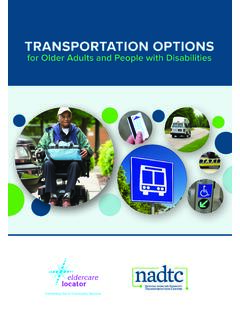Transcription of U. S. Department of Transportation National Highway ...
1 U. S. Department of Transportation National Highway Traffic Safety Administration Office of Emergency Medical Services (EMS). Lights and Siren Use by Emergency Medical Services (EMS): Above All Do No Harm Author: Douglas F. Kupas, MD, EMT-P, FAEMS, FACEP. Submitted by Maryn Consulting, Inc. For NHTSA Contract DTNH22-14-F-00579. About the Author Dr. Douglas Kupas is an EMS physician and emergency physician, practicing at a tertiary care medical center that is a Level I adult trauma center and Level II pediatric trauma center. He has been an EMS provider for over 35 years, providing medical care as a paramedic with both volunteer and paid third service EMS agencies. His career academic interests include EMS patient and provider safety, emergency airway management, and cardiac arrest care. He is active with the National Association of EMS. Physicians (former chair of Rural EMS, Standards and Practice, and Mobile Integrated Healthcare committees) and with the National Association of State EMS Officials (former chair of the Medical Directors Council).
2 He is a professor of emergency medicine and is the Commonwealth EMS Medical Director for the Pennsylvania Department of Health. Disclosures The author has no financial conflict of interest with any company or organization related to the topics within this report. The author serves as an unpaid member of the Institutional Research Review Committee of the International Academy of Emergency Dispatch, Salt Lake City, UT. The author is employed as an emergency physician and EMS physician by Geisinger Health System, Danville, PA. The author is employed part-time as the Commonwealth EMS Medical Director by the Pennsylvania Department of Health, Bureau of EMS, Harrisburg, PA. The interpretations and views expressed within this report are those of the author and do not represent the views or opinions of Geisinger Health System, the Pennsylvania Department of Health, or any other organization.
3 Acknowledgements The author acknowledges N. Clay Mann, PhD, MS and Mengtao Dai, MStat at the National EMS Information System (NEMSIS) Technical Assistance Center for assistance with the analysis of NEMSIS data related to the current use of lights and siren in the United States. Page 2 of 98. National Highway Traffic Safety Administration (NHTSA). Emerging Issues in EMS and 911: Contract DTNH22-14-F-00579. Lights and Siren Use by Emergency Medical Services (EMS) May 2017. Contents List of Frequently Used 4. Executive Summary .. 5. Section 1 7. Section 2 Current Use of Lights & Siren in the U. S.. 9. Section 3 Review of State Laws Regarding Lights and Siren Use by EMS .. 19. Section 4 Discussion .. 21. Use and Usefulness of Emergency Warning Lights and Vehicle Conspicuity .. 21. Use and Usefulness of Sirens .. 25. Time Saved with L&S .. 30. The Association between L&S Driving and Crash Risk.
4 32. Traffic Signal Preemption Devices .. 35. Hazards of L&S Use for EMS Providers .. 35. Emergency Medical Dispatch and L&S 36. Clinical Considerations Related to L&S Use during Transport .. 39. public Perceptions and Expectations for L&S Use .. 43. Recommendations for EMS Vehicle Operations Policies .. 45. Annotated 51. Literature Search Methodology .. 51. EMS Vehicle Crash Statistics, Driving (including Driver Training), Liability, and Ethics .. 52. Effectiveness of Warning Lights and Sirens (and Vehicle Conspicuity) .. 65. Time Saved with Lights and Siren Response and Transport .. 70. Traffic Signal Preemption 76. public Perception and Expectations Related to Lights and Siren Use .. 77. Provider Safety Issues when Using Lights and Sirens .. 79. Emergency Medical Dispatch and Lights and Sirens Response .. 82. Clinical Outcomes with Lights and Siren (including Physiologic Effects).
5 87. EMS Operations, Policies, and Guidelines Related to Lights and Siren Use .. 94. List of Frequently Used Abbreviations ACEP American College of Emergency Physicians dB Decibel DRLs Daytime Running Lights EMD Emergency Medical Dispatch or Dispatcher EMS Emergency Medical Services EMSVOs EMS Vehicle Operators NEMSIS National EMS Information System L&S Lights and Siren NAEMSP National Association of EMS Physicians NHTSA National Highway Traffic Safety Administration USFA U. S. Fire Administration Page 4 of 98. Executive Summary Primum non nocere first do no harm. This principle of medical care helps to guide medical decisions by reminding healthcare providers that while attempting to provide treatments to improve a patient's outcome, there are risks that can cause harm. Providing healthcare requires a constant assessment of the impact of certain interventions on patient outcome while balancing that with the risks associated with the intervention.
6 The primary role of Emergency Medical Services (EMS) providers and agencies is to deliver healthcare, often for medical emergencies, and weighing the risks and benefits of all aspects of delivering care including the risks and benefits of the treatment of lights and siren (L&S) use should be part of this practice of medicine. Another tenant of medicine is that treatments that have a known risk should be delivered in the lowest possible effective dose. This applies to chemotherapy that may be life-saving but has also may have a high risk of serious side effects. In radiology, the ALARA principle attempts to reduce radiation exposure from x-rays and CT scans to doses that are as low as reasonably achievable to make diagnoses while minimizing the hazards of radiation. We can apply this same medical principle to the use of L&S. There are some situations where the medical treatment of L&S use can improve patient outcome by the time that it saves, but there is a risk when L&S lead to EMS.
7 Vehicle crashes, provider or patient injury, EMS provider hearing loss, or worsened patient condition due to anxiety and stress. It is even possible that excessive use of L&S. by an EMS agency causes some patients with legitimate emergencies to choose private vehicle Transportation to the hospital rather than calling 911 due to the sirens and attention. This report begins by exploring the traditional reasons for L&S use by EMS. Data from most EMS incidents in the United States is provided to the National EMS Information System (NEMSIS)1 by EMS agencies. This report uses the NEMSIS data from 2015 to gain a perspective on the current use of L&S, during both response to 911 scene incidents and transport of these patients to a medical facility. The Uniform Vehicle Code2 attributes related to emergency vehicle operations will be reviewed, and examples of variations in the laws and regulations for L&S use by EMS are discussed.
8 The discussion section will review the evidence and expert opinion from both scientific studies and non-peer reviewed journals related to L&S use. This discussion includes topics of effectiveness of emergency warning lights, vehicle conspicuity, and the effectiveness of sirens and traffic light preemption systems. L&S are useful in gaining attention when requesting the right of way , but neither warning lights nor siren are 1. The National EMS Information System, NEMSIS, provides the framework for collecting, sharing, and storing standardized EMS data for states across the nation. Currently, more than 90% of the states and U. S. territories have a NEMSIS-compliant data system with varying degrees of sophistication. 2. The Uniform Vehicle Code is the set of U. S. traffic laws prepared and compiled by the National Committee of Uniform Traffic Laws and Ordinances (NCUTLO). NCUTLO is a private, non-profit organization.
9 Most of the members of NCUTLO are state governments and related organizations. Page 5 of 98. always effective. EMS vehicle operators (EMSVOs) must always assume that the motoring public and pedestrians do not see or hear the EMS vehicle. The time saved by using L&S during response and transport has been evaluated by several studies. These all show that a relatively short amount of time is saved by L&S. use. While this may be of clinical importance to patient outcome in critical time-sensitive conditions like cardiac arrest, the consensus among the researchers in this field is that the time is not significant in most of the responses or transports. In addition to the amount of time saved with L&S transport, an equally important discussion is whether that time is clinically important to patient outcome. For most conditions, EMS professionals can provide appropriate care to reduce the importance of saving a few minutes by L&S transport.
10 While we do not fully understand the potential negative physiologic effects from L&S use, any EMS vehicle crash that occurs when exercising the privileges of L&S is detrimental to the health of both EMS providers and their patients. Each section includes many considerations and recommendations for states, jurisdictions, EMS agencies, and EMSVOs. These recommendations are organized and concentrated in the final section of the report. While there are many recommendations related to agency policy, vehicle design, L&S use, and EMS vehicle driving, the most important suggestions are probably the suggestion that every agency analyze the potential time benefits and risks of L&S use in their community. Each agency should measure their L&S use during response and transport, and quality improvement processes should be used to reduce the use of L&S response and transport to the minimum effective rate.
